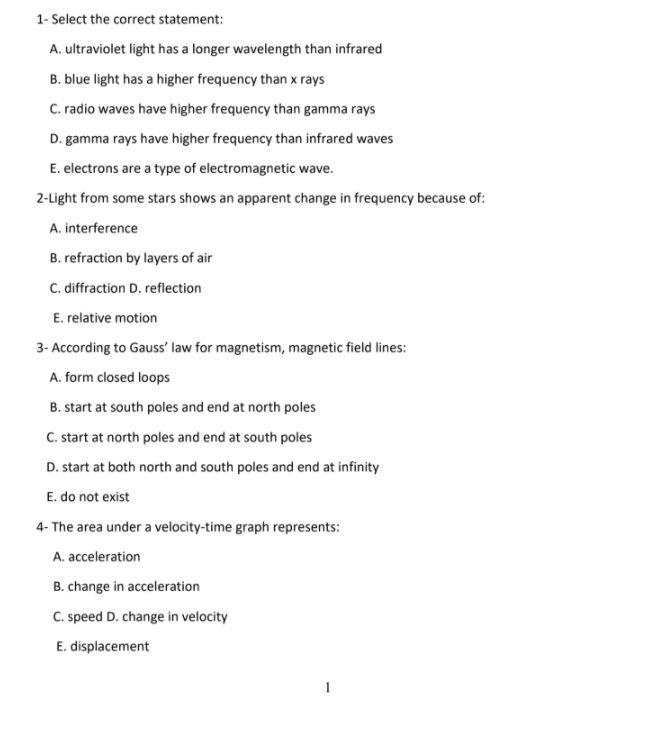1- Select the correct statement: A. ultraviolet light has a longer wavelength than infrared B. blue light has a higher frequency than x rays C. radio waves have higher frequency than gamma rays D. gamma rays have higher frequency than infrared waves E. electrons are a type of electromagnetic wave.
1- Select the correct statement: A. ultraviolet light has a longer wavelength than infrared B. blue light has a higher frequency than x rays C. radio waves have higher frequency than gamma rays D. gamma rays have higher frequency than infrared waves E. electrons are a type of electromagnetic wave.
Physics for Scientists and Engineers, Technology Update (No access codes included)
9th Edition
ISBN:9781305116399
Author:Raymond A. Serway, John W. Jewett
Publisher:Raymond A. Serway, John W. Jewett
Chapter34: Electromagnetic Waves
Section: Chapter Questions
Problem 34.75AP
Related questions
Question
help

Transcribed Image Text:1- Select the correct statement:
A. ultraviolet light has a longer wavelength than infrared
B. blue light has a higher frequency than x rays
C. radio waves have higher frequency than gamma rays
D. gamma rays have higher frequency than infrared waves
E. electrons are a type of electromagnetic wave.
2-Light from some stars shows an apparent change in frequency because of:
A. interference
B. refraction by layers of air
C. diffraction D. reflection
E. relative motion
3- According to Gauss' law for magnetism, magnetic field lines:
A. form closed loops
B. start at south poles and end at north poles
C. start at north poles and end at south poles
D. start at both north and south poles and end at infinity
E. do not exist
4- The area under a velocity-time graph represents:
A. acceleration
B. change in acceleration
C. speed D. change in velocity
E. displacement
Expert Solution
This question has been solved!
Explore an expertly crafted, step-by-step solution for a thorough understanding of key concepts.
This is a popular solution!
Trending now
This is a popular solution!
Step by step
Solved in 2 steps

Knowledge Booster
Learn more about
Need a deep-dive on the concept behind this application? Look no further. Learn more about this topic, physics and related others by exploring similar questions and additional content below.Recommended textbooks for you

Physics for Scientists and Engineers, Technology …
Physics
ISBN:
9781305116399
Author:
Raymond A. Serway, John W. Jewett
Publisher:
Cengage Learning

Physics for Scientists and Engineers
Physics
ISBN:
9781337553278
Author:
Raymond A. Serway, John W. Jewett
Publisher:
Cengage Learning

Physics for Scientists and Engineers with Modern …
Physics
ISBN:
9781337553292
Author:
Raymond A. Serway, John W. Jewett
Publisher:
Cengage Learning

Physics for Scientists and Engineers, Technology …
Physics
ISBN:
9781305116399
Author:
Raymond A. Serway, John W. Jewett
Publisher:
Cengage Learning

Physics for Scientists and Engineers
Physics
ISBN:
9781337553278
Author:
Raymond A. Serway, John W. Jewett
Publisher:
Cengage Learning

Physics for Scientists and Engineers with Modern …
Physics
ISBN:
9781337553292
Author:
Raymond A. Serway, John W. Jewett
Publisher:
Cengage Learning

College Physics
Physics
ISBN:
9781285737027
Author:
Raymond A. Serway, Chris Vuille
Publisher:
Cengage Learning

College Physics
Physics
ISBN:
9781305952300
Author:
Raymond A. Serway, Chris Vuille
Publisher:
Cengage Learning

College Physics
Physics
ISBN:
9781938168000
Author:
Paul Peter Urone, Roger Hinrichs
Publisher:
OpenStax College